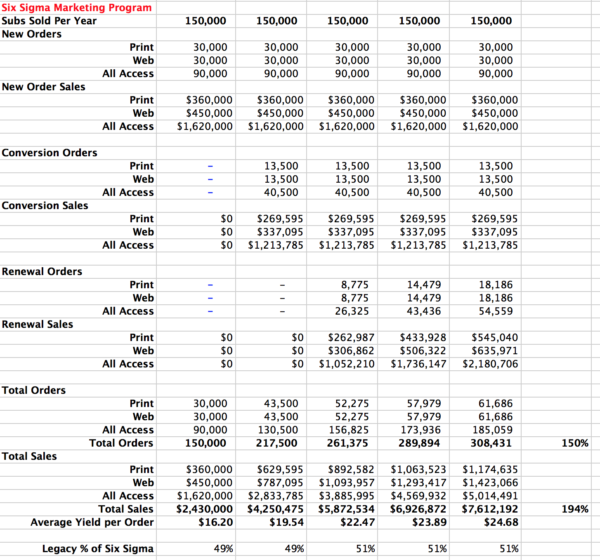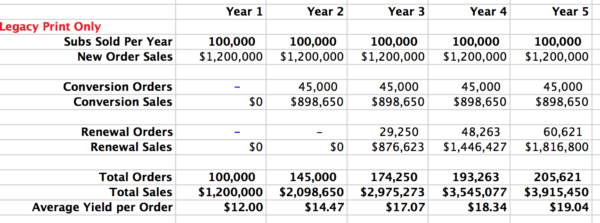
While the challenge of choosing the right subscription pricing and single-copy pricing strategy is not new to magazine publishers, it’s virgin territory for most subscription website publishers and for many publishers exploring the digital newsstand landscape.
Even magazine publishers are faced with new economic realities when pricing publications online.
The marginal cost of delivering a digital subscription to your own website is near zero. The cost of delivering digital issues via digital newsstands and app stores is based on remit and the cost of delivering a digital issue paid to your digital publishing software provider (Mag+, Adobe Digital Publishing Suite, etc.).
While the above is new, an Excel spreadsheet can help you map the right solution easily. The tougher decision is deciding how to position subscription versus single copy or limited access. It would be nice if there were a one-size-fits-all solution to this problem. There’s not. Depending upon your brand, delivery channels, and publishing economics (user, sponsor, or some hybrid of the two), one of these three solutions might be best for you.
[text_ad]
Traditional pricing
You’ll find that those who aren’t bundling subscription products into membership products through Universal Pricing or Contrast Pricing will be best served by the guidelines below:
Be fair and balanced: If you want to neutralize price in the subscription versus single-copy decision-making process, use the fair and balanced approach. Assuming you’re selling either a monthly issue or monthly access or both, set your price ratio at four-to-one. For a mass-market consumer brand, it might ideally be $19.97 per year or $4.97 per month (issue).
Encourage sampling: It’s been said that consumers generally don’t like commitment. When considering the purchase of an information product with which they’re unfamiliar, they may prefer to buy just one as a way to sample the content. If you want to encourage this behavior and thus maximize your single copy or monthly access sales, price your annual subscription at $19.97 and price monthly access or single copies at $2.97. This pricing strategy still provides a powerful incentive to take the annual option, but will result in a much higher percentage of people that take the single copy or monthly access price. It’s worth noting there’s a huge difference in the long-term economics of selling monthly access to a subscription website for $2.97 on a recurring basis, compared to selling a single magazine or newsletter issue through a subscription application for $2.97 on a non-recurring basis.
Push the subscription: If your overall economics favor selling subscriptions, consider what many now call “no-brainer pricing,” which sets a ratio of about two-to-one. Assuming we’re still talking about a subscription priced at $19.97, this strategy would dictate a single copy or monthly access price of $9.97. Note: In all the above cases we avoided avalanche price barriers like $10 and $20. This, of course, is a testable element.
While many magazine and newsletter publishers have avoided building subscription websites and thus avoided the above decision matrix until now, the rapid growth of tablet computers and the sale of tablet-based app subscriptions is dragging them to include digital subscription marketing in their core long-term publishing strategy.
If you’re not bundling your services, follow the guidelines above.
However, as publishers begin to include website access in their long-term publishing strategy, they’re beginning to discover other ways of bundling web access into print and digital packages. The first, Universal Pricing, bundles platforms at a discount, but the second, Contrast Pricing, we’re finding is more profitable and gets consumers to choose higher-priced bundles.
Universal subscription pricing
Universal Digital Access, as a policy, creates an environment where subscribers can safely sample different platforms without fear of being left behind. From the publishers point of view, a subscriber is a horrible thing to waste, and anyone who subscribes to content on any platform, in any edition, is given premium access to their subscription website.
Contrast subscription pricing
While some mega-publishers still employ the universal pricing strategy, others have moved to our new favorite pricing model, contrast pricing – also known, less politely, as decoy pricing.
Contrast pricing takes advantage of the psychological phenomenon in which human beings, when asked to make a choice, tend to rely on the relative value of things compared and contrasted to other similar things. This theory has been beautifully illustrated in depth by Dan Ariely, Professor of Psychology and Behavioral Economics at Duke University, in his New York Times bestseller Predictably Irrational: The Hidden Forces That Shape Our Decisions.
It’s the same phenomenon, Ariely notes, that causes our headaches to persist when we take a cheap pain pill, but magically alleviates them when we take a much more expensive remedy. As long as we have something to contrast a purchase with, we’ll choose the one that seems most valuable by contrast.
Ariely most famously examined The Economist years back, before digital magazines, when it made this offer:
- $59 – Subscription to the website
- $125 – Subscription to the print edition
- $125 – Subscription to the website and the print edition
The decoy price was the middle one: $125 for the print edition alone, when you could have the print edition and the website for the same price, was undesirable, and only served to establish the higher value of the last offer. That’s what I call maximizing your revenues!
Although we don’t have any numbers from The Economist to show how well it worked, Ariely ran a test by asking students to choose which offer they’d prefer. Unsurprisingly, the decoy worked beautifully, driving consumers to the highest-priced offer:
- $59 – Website only: 16%
- $125 – Print edition only: 0%
- $125 – Website and print edition: 84%
Next, he removed the decoy price that made the last offer seem to be the most attractive. The results changed dramatically:
- $59 – Website only: 68%
- $125 – Website and print edition: 32%
The lesson? Bundle that digital magazine with at least one other product, and make sure you have three or more offers to drive more buyers to the highest price point.
[text_ad]
All-access subscription pricing
The models above, though compliant with the digital age, are still fairly traditional. The pricing strategy we’ve seen work best is all-access. All-access implies the subscriber now becomes a member of a club-like product where they can access archives of content and multiple digital products.
Below is a case study showing how a single-platform publisher could increase revenue over five years by switching from selling print-only subscriptions online to selling a multiplatform all-access membership.
- They sell 100,000 print subscriptions per year online with an introductory $12 offer, yielding an average of $12 per order.
- They offer print-only for $12, web edition and library for $15, or all-access (both print and web) for $18.
- Online sales are now 50% higher thanks to the value of the web library, bringing them 150,000 orders.
- 20% of orders are for print-only, 20% are for web-only and 60% are for all-access, generating a yield of $16.20 per order.
Keeping the conversion and renewal rates the same, the all-access membership offers’ total sales are $7,612,192 by year five, and subscription revenue has nearly doubled.

Offering an all-access pass with a magazine archive, and likely other benefits like special collections and more, allows a publisher to increase the number of all-access premium memberships sold online at a significantly higher price. For a publisher already generating a substantial print only order volume, the math is incredibly compelling.
And while the above analysis does not assume any change in the overall marketing efforts beyond the change in offer and the availability of the all-access pass, in reality, we’d be initiating a high-frequency Six Sigma marketing program. This program would be anchored by the all-access membership and could produce another 50,000 to 100,000 orders annually depending on the size of the existing database, website traffic levels and email capture rates.
More subscription pricing data on the way
Every so often we hear from a colleague or client who has new data about the best subscription pricing and promotion strategies for their magazine websites. In many cases, they hadn’t even considered how single copy or monthly access pricing should play into their overall marketing and pricing strategy. That’s changing quickly. As new data and case studies appear, you can count on us to cover them here.
In the meantime, read more about Six Sigma offer testing and our 12 best offers to test.
What else would you like to know about subscription pricing?
This post was originally published in 2014 and has been updated regularly.
[text_ad]




My team found these tips to be extremely helping in helping us make decisions about pricing our new line of eBooks. We appreciated the rationale for each strategy, which led us to choose what would best fit our subscription product (short reports) and a new product line of eBooks. Thanks so much!